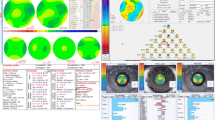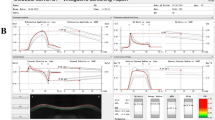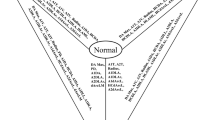Abstract
Objective
To investigate the diagnostic accuracy of the parameters in the Belin/Ambrósio Enhanced Ectasia Display built in Pentacam, which is designed for the screening of subclinical keratoconus (SKC) built in Pentacam, and the parameters in Corneal visualization Scheimpflug technology (Corvis ST).
Methods
A retrospective study: The fellow eyes of unilateral keratoconus cases were diagnosed with SKC. Patients presented to Shanxi Eye Hospital with SKC from October 2020 to November 2021 were included as the SKC group, and myopic patients undergoing corneal refractive surgery at the Refractive Surgery Department in our hospital within the same period were included as the control group. The Belin/Ambrósio and Corvis ST parameters were extracted from the system and analyzed using independent samples t test. Receiver operating curves (ROCs) were also created to test the diagnostic accuracy of each parameter.
Results
There were 70 patients (70 eyes) in the SKC group and 137 patients (137 eyes) in the control group. For Corvis ST parameters, Radius (P = 0.021), PachySlope (P = 0.040), SP-A1 (P = 0.002), A2 Deformation Amp. (P = 0.028), A2 Deflection Length (P < 0.001), Max ICR (P = 0.005), DA Ratio Max (1 mm) (P = 0.023), IR (P = 0.016), CBI (P = 0.003) and TBI (P < 0.001) were statistically different between the two groups. For Belin/Ambrósio parameters, PPI min. Axis, ART min, ART max, ART avg, Pachy min, Front K2, Astig, BAD-Df, BAD-Db, BAD-Dp, BAD-Dt, BAD-Da, BAD-D, PPI min, PPI max, PPI max. Axis, PPI avg and Dist.Apex-Thin.Loc. were significantly different between the two groups (all p < 0.001). TBI and BAD-D showed the best diagnostic accuracy, with AUCs of 0.944 and 0.965, respectively.
Conclusions
Some Belin/Ambrósio and Corvis ST parameters differed between SKC eyes and eyes with normal cornea. TBI and BAD-D showed the ideal diagnostic performance for SKC. In clinical practice, conventional corneal topography could not be replaced by Corvis ST.

Similar content being viewed by others
References
Mohammadpour M, Heidari Z, Hashemi H (2018) Updates on managements for keratoconus. J Curr Ophthalmol 30(2):110–124
De Sanctis U, Loiacono C, Richiardi L, Turco D, Mutani B, Grignolo FM (2008) Sensitivity and specificity of posterior corneal elevation measured by pentacam in discriminating keratoconus/subclinical keratoconus. Ophthalmology 115(9):1534–1539
Goncalves FA, Goncalves JM (2013) Corneal ectasia after LASIK in a patient with normal scheimpflug evaluation but a high ectasia risk score. J Refract Surg 29(11):792–795
Ambrósio R Jr, Dawson DG, Salomão M, Guerra FP, Caiado AL, Belin MW (2010) Corneal ectasia after LASIK despite low preoperative risk: tomographic and biomechanical findings in the unoperated, stable, fellow eye. J Refract Surg 26(11):906–911
Bae GH, Kim JR, Kim CH, Lim DH, Chung ES, Chung TY (2014) Corneal topographic and tomographic analysis of fellow eyes in unilateral keratoconus patients using pentacam. Am J Ophthalmol 157(1):103-109.e1
Herber R, Terai N, Pillunat KR, Raiskup F, Pillunat LE, Spörl E (2018) Dynamic Scheimpflug Analyzer (Corvis ST) for measurement of corneal biomechanical parameters : a praxis-related overview. Ophthalmologe 115(8):635–643
Henriquez MA, Hadid M, Izquierdo L Jr (2020) A systematic review of subclinical keratoconus and forme fruste keratoconus. J Refract Surg 36(4):270–279
Rabinowitz YS (1998) Keratoconus. Surv Ophthalmol 42(4):297–319
Salomão MQ, Hofling-Lima AL, Faria-Correia F, Lopes BT, Rodrigues-Barros S, Roberts CJ, Ambrósio R (2018) Dynamic corneal deformation response and integrated corneal tomography. Indian J Ophthalmol 66(3):373–382
Muftuoglu O, Ayar O, Ozulken K, Ozyol E, Akinci A (2013) Posterior corneal elevation and back difference corneal elevation in diagnosing forme fruste keratoconus in the fellow eyes of unilateral keratoconus patients. J Cataract Refract Surg 39(9):1348–1357
Gomes JA, Tan D, Rapuano CJ, Belin MW, Ambrosio R Jr, Guell JL, Malecaze F, Nishida K, Sangwan VS, Ectatic D, Group of Panelists for the Global Delphi Panel Of K (2015) Global consensus on keratoconus and ectatic diseases. Cornea 34(4):359–369
Hashemi H, Beiranvand A, Yekta A, Maleki A, Yazdani N, Khabazkhoob M (2016) Pentacam top indices for diagnosing subclinical and definite keratoconus. J Curr Ophthalmol 28(1):21–26
Feizi S, Yaseri M, Kheiri B (2016) Predictive ability of galilei to distinguish subclinical keratoconus and keratoconus from normal corneas. J Ophthalmic Vis Res 11(1):8–16
Li Y, Chamberlain W, Tan O, Brass R, Weiss JL, Huang D (2016) Subclinical keratoconus detection by pattern analysis of corneal and epithelial thickness maps with optical coherence tomography. J Cataract Refract Surg 42(2):284–295
Gefen A, Shalom R, Elad D, Mandel Y (2009) Biomechanical analysis of the keratoconic cornea. J Mech Behav Biomed Mater 2(3):224–236
Scarcelli G, Besner S, Pineda R, Yun SH (2014) Biomechanical characterization of keratoconus corneas ex vivo with brillouin microscopy. Invest Ophthalmol Vis Sci 55(7):4490–4495
Steinberg J, Katz T, Lücke K, Frings A, Druchkiv V, Linke SJ (2015) Screening for keratoconus with new dynamic biomechanical in vivo scheimpflug analyses. Cornea 34(11):1404–1412
Ali NQ, Patel DV, Mcghee CN (2014) Biomechanical responses of healthy and keratoconic corneas measured using a noncontact scheimpflug-based tonometer. Invest Ophthalmol Vis Sci 55(6):3651–3659
Ambrósio R Jr, Lopes B, Faria-Correia F, Vinciguerra R, Vinciguerra P, Elsheikh A, Roberts CJ (2016) ectasia detection by the assessment of corneal biomechanics. Cornea 35(7):e18-20
Pérez-Rueda A, Jiménez-Rodríguez D (2021) Diagnosis of subclinical keratoconus with a combined model of biomechanical and topographic parameters. J Clin Med 10(13):2746
Ambrósio R Jr, Lopes BT, Faria-Correia F, Salomão MQ, Bühren J, Roberts CJ, Elsheikh A, Vinciguerra R, Vinciguerra P (2017) Integration of scheimpflug-based corneal tomography and biomechanical assessments for enhancing ectasia detection. J Refract Surg 33(7):434–443
Zhang M, Zhang F (2020) Early diagnosis of keratoconus in chinese myopic eyes by combining corvis st with pentacam. Curr Eye Res 45(2):118–123
Guo LL, Tian L, Cao K, Li YX, Li N, Yang WQ, Jie Y (2021) Comparison of the morphological and biomechanical characteristics of keratoconus, forme fruste keratoconus, and normal corneas. Semin Ophthalmol 36(8):671–678
Wu Y, Guo LL, Tian L, Xu ZQ, Li Q, Hu J, Huang YF, Wang LQ (2021) Comparative analysis of the morphological and biomechanical properties of normal cornea and keratoconus at different stages. Int Ophthalmol 41(11):3699–3711
Vinciguerra R, Ambrósio R Jr, Elsheikh A, Roberts CJ, Lopes B, Morenghi E, Azzolini C, Vinciguerra P (2016) Detection of keratoconus with a new biomechanical index. J Refract Surg 32(12):803–810
Koc M, Aydemir E, Tekin K, Inanc M, Kosekahya P, Kiziltoprak H (2019) Biomechanical analysis of subclinical keratoconus with normal topographic, topometric, and tomographic findings. J Refract Surg 35(4):247–252
Kataria P, Padmanabhan P, Gopalakrishnan A, Padmanaban V, Mahadik S, Ambrósio R Jr (2019) Accuracy of Scheimpflug-derived corneal biomechanical and tomographic indices for detecting subclinical and mild keratectasia in a South Asian population. J Cataract Refract Surg 45(3):328–336
Eliasy A, Chen KJ, Vinciguerra R, Lopes BT, Abass A, Vinciguerra P, Ambrósio R Jr, Roberts CJ, Elsheikh A (2019) Determination of corneal biomechanical behavior in-vivo for healthy eyes using CorVis ST tonometry: stress-strain index. Front Bioeng Biotechnol 7:105
Liu G, Rong H, Pei R, Du B, Jin N, Wang D, Jin C, Wei R (2020) Age distribution and associated factors of cornea biomechanical parameter stress-strain index in Chinese healthy population. BMC Ophthalmol 20(1):436
Han F, Li M, Wei P, Ma J, Jhanji V, Wang Y (2020) Effect of biomechanical properties on myopia: a study of new corneal biomechanical parameters. BMC Ophthalmol 20(1):459
Zhao W, Shen Y, Jian W, Shang J, Jhanji V, Aruma A, Zhou X (2020) Comparison of corneal biomechanical properties between post-LASIK ectasia and primary keratoconus. J Ophthalmol 2020:5291485
Ambrósio R Jr, Valbon BF, Faria-Correia F, Ramos I, Luz A (2013) Scheimpflug imaging for laser refractive surgery. Curr Opin Ophthalmol 24(4):310–320
Funding
Supported by the Doctorial Foundation of Shanxi Eye Hospital (Grant No. B202102). The receipt of above funding source is the first author of this manuscript.
Author information
Authors and Affiliations
Contributions
YS and RH designed the current study and were major contributors in writing the manuscript. YF and MQ performed surgeries. QM prepared Tables 1–2. HT prepared Tables 3–6. DL carried out corneal biomechanical and corneal topography examinations for all patients. All authors have read and approved the manuscript.
Corresponding author
Ethics declarations
Conflict of interests
The authors declare that they have no conflict of interests.
Additional information
Publisher's Note
Springer Nature remains neutral with regard to jurisdictional claims in published maps and institutional affiliations.
Rights and permissions
Springer Nature or its licensor holds exclusive rights to this article under a publishing agreement with the author(s) or other rightsholder(s); author self-archiving of the accepted manuscript version of this article is solely governed by the terms of such publishing agreement and applicable law.
About this article
Cite this article
Song, Y., Feng, Y., Qu, M. et al. Analysis of the diagnostic accuracy of Belin/Ambrósio Enhanced Ectasia and Corvis ST parameters for subclinical keratoconus. Int Ophthalmol 43, 1465–1475 (2023). https://doi.org/10.1007/s10792-022-02543-8
Received:
Accepted:
Published:
Issue Date:
DOI: https://doi.org/10.1007/s10792-022-02543-8




